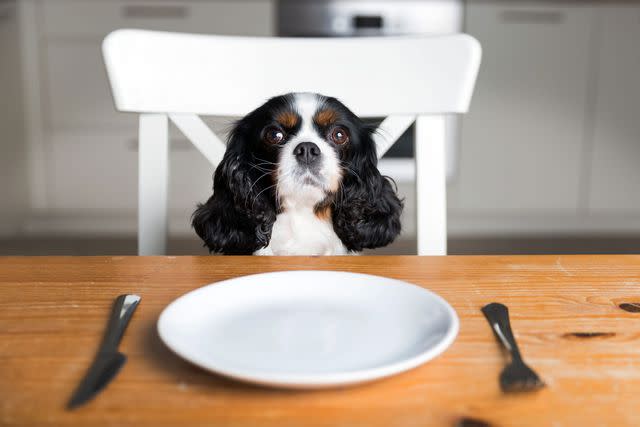Can Dogs Eat Ham Bones?

Those puppy dog eyes say yes, please. Your vet may have a different take.
Fact checked by Elizabeth Berry
Vets in the U.S. have a saying, says Don Woodman, DVM, the co-founder of the Independent Veterinary Practitioner's Association and a Safety Harbor, Florida-based vet: The months of November and December may be the holiday season, but the day after Thanksgiving and Christmas are the pancreatitis season.
Meet The Experts
Dr. Lon Lewis, DVM, is co-author of the book Small Animal Clinical Nutrition. Now retired, Dr. Lewis has made a name for himself as the developer of the popular dog treat Greenies.
Dr. Don Woodman, DVM, is a graduate of Virginia Tech’s School of Veterinary Medicine. He is the owner of the Animal Hospital of Northwood in Safety Harbor, Florida.
Dr. Katie Smithson, DVM, graduated from the University of Tennessee College of Veterinary Medicine. She is a certified small animal/equine acupuncturist.
Keep The Human Food On The Table
It's not so much the ham, specifically, that is the problem, says Lon Lewis, DVM, a board-certified veterinary nutritionist based in Topeka, Kansas. Unfortunately, people tend to grab the scraps and toss them to their pet. Those tidbits are almost universally the fatty morsels that humans don't want. For a dog, a single high-fat meal can trigger pancreatitis—or inflammation of the pancreas. If not caught quickly and treated, pancreatitis can be fatal, says Dr. Woodman.

Pork Poses Problems
Even trimmed of fat, some veterinarians have hesitations about pork products, says Dr. Woodman. Traditionally, they've been seen as being slightly riskier for triggering pancreatitis, though he adds that that is likely more based on anecdotal evidence than anything else.
There are other problems with ham. Sodium, which causes human nutritionists to put ham on the naughty list, isn't a massive problem for healthy canines. However, too much salt can be dangerous for a dog with cardiac problems, says Katie Smithson, a Chattanooga-based veterinarian. "And really, there are so many other things they could have as treats that aren't super salty," she adds.
Bones Are Not A Safe Bet
As for the leftover ham bone, that's far too delicious in a pot of bean soup to sacrifice to your pooch. It's not good for them, either. Dr. Woodman says bones can end in broken teeth and esophageal blockages—when part of the bone lodges in the esophagus. Signs your dog has an esophageal blockage include coughing, gagging, drooling, and throwing up. This, like pancreatitis, is a veterinary emergency. Dr. Smithson adds that because cooked bones don't break down easily in the GI tract, ham bones can cause major internal damage. Really, you shouldn't feed your dog any type of cooked bone at all, she advises.
If you're dead-set on giving your dog a holiday treat, you'd be better served by a slice of turkey, some cooked green beans, or even some sweet potatoes (before you load them up with butter and cream). If you've read this far and still want to give them ham, keep the sliver tiny and trim it of all excess fat.
What If Puppy Sneaks A Snack?
If your pooch grabs the Christmas ham off the counter when no one is looking, you should immediately call your nearest emergency vet. The severity of the consequences will depend on your dog's size and how much they polished off before you heard those snarfing sounds coming from your kitchen. Either way, a vet needs to be involved.
It isn't just pork that can harm your sweet pooch. Dogs can suffer from a very serious condition called bloat if they eat too much too quickly. Much like humans, a dog’s stomach resembles a balloon. For humans, overeating and eating too quickly can result in bloating, gas, and general discomfort, but we can recover quickly. Dogs, however, are not so fortunate, and what begins as gas can soon turn into something much worse. The symptoms of bloat are listed below.
Change in personality and physical activity level
Abdomen is larger, distended, and hard
Lack of normal digestive sounds (place your ear on your dog’s stomach and note if there is any difference)
Standing in a hunched-over position, unable to get comfortable
Refusing to lie on their side
Dry heaving or vomiting foam or mucus
Anxiety
Pacing
Whining
Licking the air
Looking at their abdomen
Standing with their legs spread
Shallow breathing
Weak pulse
Collapsing to the ground
Cold gums that are dark red (or blue or white in later stages)
Unable to defecate
A Long Term Commitment
Understanding that your dog's dietary do not require human food makes a difference. Break the habit of table scrap snacks, and work to maintain a healthy weight for your dog. In recent years, the rate of overweight dogs has increased by 158%. Around 37% of dogs are overweight by the time they reach 6 months of age.
Another very logical approach to maintaining your dog's healthy diet is to ensure that the serving size of their own kibble is appropriate. Take some time to learn the needs of your pet by following food serving instructions on the dog food package. Should you need further clarification, your veterinarian is there to help.
For more Southern Living news, make sure to sign up for our newsletter!
Read the original article on Southern Living.

